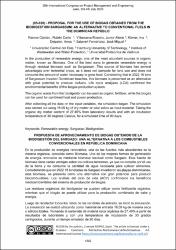| License | This article is licensed under a Creative Commons Attribution-NonCommercial-NoDerivatives 4.0 International License. | es |
| Author | Ramos Ciprián, Rubén Darío | |
| Author | Villanueva Rosario, Junior Alexis | |
| Author | Körner, Ina | |
| Author | Deipster, Anna | |
| Author | Salavert Fernández, José Miguel | |
| Accessioned date | 2025-01-13T21:28:48Z | |
| Available date | 2025-01-13T21:28:48Z | |
| Year | 2024 | |
| Citation | Ramos Ciprián, R. D., Villanueva Rosario, J. A., Körner, I., Deipster, A., & Salavert Fernández, J. M. (2024). Proposal for the use of biogas obtained from the biodigestion sargassum: an alternative to conventional fuels in the Dominican Republic. 28th International Congress on Project Management and Engineering, Jaén, 3rd-4th July 2024, 1502-1514. Recuperado de: | es |
| URI | https://bvearmb.do/handle/123456789/5634 | |
| Abstract | [English] In the production of renewable energy, one of the most abundant sources is organic matter, known as Biomass. One of the best ways to generate renewable energy is through residual biomass such as Sargassum. This source of biomass has several advantages over terrestrial crops, as it does not compete for land use and does not consume the amount of water necessary to grow food. Considering that in 2022 18 tons of Sargassum invaded Dominican beaches, this biomass is presented as an alternative with great potential to produce biofuels. Life cycle analyzes (LCA) confirmed the environmental benefits of the biogas production system. The organic waste from the biodigester can be used as organic fertilizer, while the biogas can be used for combined heat and power production. After collecting all the data on the input variables, the simulation began. The simulation was carried out using 18.09 kg of dry matter or total solids as input material. Taking the organic dry matter content of 27.49% from laboratory results and with an incubation temperature of 30 degrees Celsius, for a simulated time of 90 days. | es |
| Abstract | [Spanish] En la producción de energías renovables, una de las fuentes más abundantes es la materia orgánica, conocida como Biomasa. Una de las mejores formas de generación de energía renovable es mediante biomasa residual como Sargazo. Esta fuente de biomasa tiene varias ventajas sobre los cultivos terrestres, ya que no compite por el uso de la tierra y no consume la cantidad de agua necesaria para cultivar alimentos. Considerando que en 2022 18 toneladas de Sargazo invadieron las playas dominicanas, esta biomasa, se presenta como una alternativa con gran potencial para producir biocombustibles. Los análisis del ciclo de vida (ACV) confirmaron los beneficios medioambientales del sistema de producción de biogás. Los residuos orgánicos del biodigestor se pueden utilizar como fertilizante orgánico, mientras que el biogás se puede utilizar para la producción combinada de calor y energía. Luego de recolectar todos los datos de las variables de entrada, se inició la simulación. La simulación se realizó utilizando como material de entrada 18,09 kg de materia seca o sólidos totales. Tomando el contenido de materia seca orgánica de 27,49% a partir de resultados de laboratorio y con una temperatura de incubación de 30 grados centígrados, durante un tiempo simulado de 90 días. | es |
| Language | English | es |
| Published | 28th International Congress on Project Management and Engineering, Jaén, 3rd-4th July 2024, 1502-1514 | es |
| Rights | ©2024 by the authors. Licensee AEIPRO, Spain. | es |
| Rights URI | https://creativecommons.org/licenses/by-nc-nd/4.0/ | es |
| Subject | Recursos naturales - República Dominicana | es |
| Subject | Recursos costeros y marinos | es |
| Subject | Contaminación ambiental | es |
| Subject | Tecnología | es |
| Subject | Energías renovables | es |
| Title | Proposal for the use of biogas obtained from the biodigestion sargassum : an alternative to conventional fuels in the Dominican Republic | es |
| dc.title.alternative | Propuesta de aprovechamiento de biogás obtenido de la biodigestión del sargazo : una alternativa a los combustibles convencionales en República Dominicana | es |
| Material type | Article | es |
| Type of content | Scientific research | es |
| Access | Open | es |
| Audience | Technicians, professionals and scientists | es |


